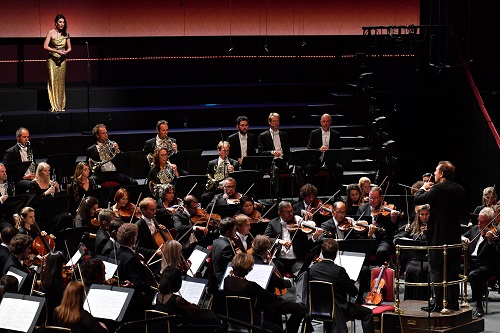
 United Kingdom 2017 BBC PROMS 66 – Haydn and Mahler: Chen Reiss (soprano), Royal Concertgebouw Orchestra / Daniele Gatti (conductor), Royal Albert Hall, London, 2.9.2017. (AS)
United Kingdom 2017 BBC PROMS 66 – Haydn and Mahler: Chen Reiss (soprano), Royal Concertgebouw Orchestra / Daniele Gatti (conductor), Royal Albert Hall, London, 2.9.2017. (AS)
-

Chen Reiss (soprano), Royal Concertgebouw Orchestra & Daniele Gatti (conductor)
(c) Chris Christodoulou
Haydn – Symphony No.82 in C, Hob 1:82, The Bear
Mahler – Symphony No.4 in G
This programme provided a neat juxtaposition of two composers who have experienced very different degrees of exposure in recent Prom seasons. There was one year at least when Haydn’s music was completely unrepresented. Last year we had one of his masses, even, and this year two of his symphonies have been played. One hopes that this very great composer will receive better treatment at the Proms from now on.
On the other hand, Mahler’s music has fared better at the Proms recently than perhaps any other composer of importance: the Fourth Symphony itself has been played nine times since the beginning of the twenty-first century. One reason for this popularity is that visiting orchestras from abroad like to show off their prowess in his large-scale, wide-ranging scores: this year, in addition to the Royal Concertgebouw we have had Mahler symphonies from the Vienna Philharmonic and Pittsburgh Symphony orchestras as well as two from local ensembles. A total of five is less than has been the case in some years. Dare one hope that this downward trend will continue and that other very deserving composers won’t be squeezed out so much by too much Mahler?
For Haydn’s symphony Gatti used the reduced string forces that now seem to be almost obligatory in performances of his orchestral works. Perhaps a head count would have been in order, since the forces involved might even have been less than the 60 players present at the work’s premiere. What was striking from the outset was a quality of warmth from even the small string section, and a general euphony of sound that was attractive in a way: but though Gatti’s conducting was exemplary in its style, the textures should have been more varied, sharper and more clearly defined; there should have been more aural contrast in the exchanges between strings and wind instruments.
Tempi were well-judged. The determined vigour of the opening movement was nicely conveyed, as was the open-hearted nature of the Allegretto and the stately quality of the Menuet, with no slowing down for the trio section. And the finale proceeded at a just speed, even if accents were a little too smoothed out. It was altogether a performance rather bathed by Gatti in his native Italian sunshine. But what a marvellous symphony it is, like so many by Haydn, full of wonderfully imaginative invention and perfectly constructed.
The first movement of the Mahler symphony hadn’t proceeded very far before it was clear that Gatti was going to be doing things with the music. The initial tempo, after the Johann Strauss-like beginning of the work, was quite brisk and urgent, but soon Gatti introduced variations of pulse and tempo that might even have surprised Willem Mengelberg, his great predecessor at the Concertgebouw from 1895 to 1945, who was a friend and champion of Mahler, and known for his very free interpretations of his music – as we can hear in his live 1939 recording of this very symphony. So perhaps Gatti was reverting to an old and authentic tradition. Better that, in any case, than the relentlessly steady ‘chug-chug’ that some conductors impose on this movement. The way Gatti manipulated the end of it did however rather take things to extreme.
By contrast, the succeeding scherzo was taken at a good, even tempo, with not too many unwonted variations of tempo in the two trio sections. But the long slow movement seemed very long indeed, since at times the music almost came to a halt through some very over-mannered turns of phrase, and despite the heavenly quality of the string playing progress in general was distinctly earthbound. What a relief it was then to experience the beautiful singing of Chen Reiss in the final movement. Her slow, elegant progress from the wings of the hall to the raised section at the back of the orchestra had been a pardonable visual distraction during the final longueurs of the slow movement, almost to indicate that better things were about to happen, and sure enough they did when she started to sing. Hers was a perfect realisation of Mahler’s Des Knaben Wunderhorn setting to end the concert.
Alan Sanders